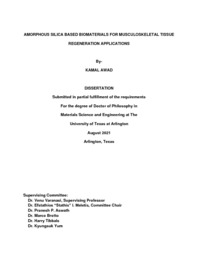
ATTENTION: The works hosted here are being migrated to a new repository that will consolidate resources, improve discoverability, and better show UTA's research impact on the global community. We will update authors as the migration progresses. Please see MavMatrix for more information.
Show simple item record
| dc.contributor.advisor | Varanasi, Venu | |
| dc.contributor.advisor | Meletis, Efstathios “Stathis” | |
| dc.contributor.advisor | Aswath, Pranesh | |
| dc.contributor.advisor | Brotto, Marco | |
| dc.creator | Awad, Kamal | |
| dc.date.accessioned | 2023-06-27T20:32:45Z | |
| dc.date.available | 2023-06-27T20:32:45Z | |
| dc.date.created | 2021-08 | |
| dc.date.issued | 2021-08-02 | |
| dc.date.submitted | August 2021 | |
| dc.identifier.uri | http://hdl.handle.net/10106/31334 | |
| dc.description.abstract | Musculoskeletal (MSK) injury includes any injuries that affect the bones, muscles, ligaments, tendons, or nerves. Open bone fracture is one of the common types of MSK traumatic injuries which results in not only bone fracture but also damage/loss of associated muscles, nerve, vasculature, endothelium, periosteum, fascia, and connective tissue. Surgical procedures and biological interventions are required to fix the broken bone, and muscle transfer is performed to compensate the skeletal muscle defects. Current treatments include fixative metal implants and regenerative biopolymer scaffolds, then muscle flap procedures to cover the bone. Yet, these treatments are inadequate because the used materials do not stimulate rapid tissue regeneration. Thus, novel materials that lead to stability and rapid healing are vital for rapid MSK tissue regeneration. The proposed research is a step towards developing new materials and hydrogels doped with nanoparticles (NPs) for MSK tissue regeneration. For this purpose, the investigator utilized silica-based biomaterials through the Si-O-N-P elements system to deliver specific chemistries at the injury vicinity to trigger preferable biological behaviors. Our central hypothesis is that amorphous silica-based biomaterials could promote rapid bone healing and functional muscle regeneration via osteokines, myokines, and antioxidant activity. Amorphous silica-based thin-film coatings were prepared by Plasma Enhanced Chemical Vapor Deposition (PECVD) technique while novel chemical synthesis approach was tested and optimized to synthesize SiONx-NPs. 3D printing technology was used to print different biopolymer scaffolds doped with NPs with and without cell laden for tissue regeneration applications. XPS, XANES, SPM, HR-SEM, HR-TEM, and nano-indentation were employed to analyze and characterize the studied materials. Cell culture studies were performed to study the effect of the synthesized materials on the cellular behavior and tissue regeneration. As outcomes, this study presented new materials that enhance the osteogenesis and myogenesis for an optimal treatment and stability for MSK injuries. | |
| dc.format.mimetype | application/pdf | |
| dc.language.iso | en_US | |
| dc.subject | Tissue engineering | |
| dc.subject | Bone | |
| dc.subject | Muscles, Implants | |
| dc.subject | Nanoparticles | |
| dc.subject | Oxidative stress | |
| dc.title | AMORPHOUS SILICA BASED BIOMATERIALS FOR MUSCULOSKELETAL TISSUE REGENERATION APPLICATIONS | |
| dc.type | Thesis | |
| dc.date.updated | 2023-06-27T20:32:45Z | |
| thesis.degree.department | Materials Science and Engineering | |
| thesis.degree.grantor | The University of Texas at Arlington | |
| thesis.degree.level | Doctoral | |
| thesis.degree.name | Doctor of Philosophy in Materials Science and Engineering | |
| dc.type.material | text | |
| dc.creator.orcid | 0000-0003-3621-1136 | |
Files in this item
- Name:
- AWAD-DISSERTATION-2021.pdf
- Size:
- 13.30Mb
- Format:
- PDF
This item appears in the following Collection(s)
Show simple item record


